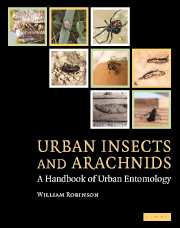Summary
Introduction
Urban and suburban environments provide suitable habitats for a small number of scorpions, spiders, mites, millipedes, and centipedes, and other arthropods. Many of these live in stable populations in peridomestic habitats, such as turfgrass, flowers and shrubs, and ornamental trees. Individuals or groups of individuals from these outdoor populations occasionally enter structures. They rarely become established as pests indoors, because of the unsuitable environmental conditions and limited resources such as food and harborage. However, some arthropods have adapted to living indoors, in residential and commercial buildings. The populations and body size of these arthropods are usually small, and they usually remain unnoticed in basements, cellars, attics, and other secluded sites.
Pest status for arthropods that occur in peridomestic and domestic habitats is based primarily on their threat to the health and safety of people and pets. Spiders, scorpions, mites, and centipedes pose actual and perceived threats of painful bites and stings, and the medical consequences that follow. For some individuals, the bite or sting produces an immediate life-threatening anaphylactic or neurotoxic reaction or long-term illness by the transmission of bacterial or rickettsial disease organisms. Rocky Mountain spotted fever is an important tick-borne disease in suburban areas in southeastern USA. Human cases of this tick-borne disease have increased in areas where suburban development has expanded into farm- and woodland ecosystems.
- Type
- Chapter
- Information
- Urban Insects and ArachnidsA Handbook of Urban Entomology, pp. 389 - 440Publisher: Cambridge University PressPrint publication year: 2005



